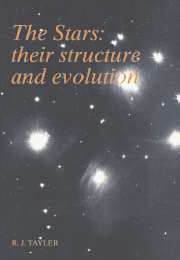Book contents
- Frontmatter
- Contents
- Preface
- Symbols
- Numerical values
- 1 Introduction
- 2 Observational properties of stars
- 3 The equations of stellar structure
- 4 The physics of stellar interiors
- 5 The structure of main sequence stars and pre-main-sequence evolution
- 6 Early post-main-sequence evolution and the ages of star clusters
- 7 Mass loss from stars
- 8 Close binary stars
- 9 Advanced evolutionary phases
- 10 The final stages of stellar evolution: white dwarfs, brown dwarfs, neutron stars and black holes
- 11 Concluding remarks
- Appendix 1 Thermodynamic equilibrium
- Appendix 2 The equation of radiative transfer
- Appendix 3 The pressure of a degenerate gas
- Suggestions for further reading
- Index
6 - Early post-main-sequence evolution and the ages of star clusters
Published online by Cambridge University Press: 05 June 2012
- Frontmatter
- Contents
- Preface
- Symbols
- Numerical values
- 1 Introduction
- 2 Observational properties of stars
- 3 The equations of stellar structure
- 4 The physics of stellar interiors
- 5 The structure of main sequence stars and pre-main-sequence evolution
- 6 Early post-main-sequence evolution and the ages of star clusters
- 7 Mass loss from stars
- 8 Close binary stars
- 9 Advanced evolutionary phases
- 10 The final stages of stellar evolution: white dwarfs, brown dwarfs, neutron stars and black holes
- 11 Concluding remarks
- Appendix 1 Thermodynamic equilibrium
- Appendix 2 The equation of radiative transfer
- Appendix 3 The pressure of a degenerate gas
- Suggestions for further reading
- Index
Summary
Historical introduction
After the main sequence the most prominent group of stars in the HR diagram (fig. 56) is the red giants and supergiants. These stars have larger luminosities and radii than main sequence stars of the same colour. From the discussion in Chapter 5, it appears that red giants are not stars of homogeneous chemical composition and I must now discover how red giants differ from main sequence stars in their internal structure as well as in their surface properties. I have already indicated at the end of Chapter 2 (fig. 30) that stars become red giants when nuclear reactions in their interiors lead to a non-uniformity of chemical composition. Before I discuss this further, I will give a brief historical introduction to the problem of the red giants. Although in this book I mainly discuss the present state of knowledge, it is perhaps instructive in one case to trace the steps by which the present knowledge has been obtained.
When the first theoretical calculations of stellar structure were made, it was very difficult to explain the occurrence of red giants, since at the time it was believed that stars remained chemically homogeneous as they evolved. As will now be described, it was believed that the rotation of stars caused them to be well mixed. Most stars are observed to rotate, even if the rotation of many of them is not sufficiently rapid to distort their structure substantially. Rotation is detected by the Doppler effect.
- Type
- Chapter
- Information
- The StarsTheir Structure and Evolution, pp. 137 - 167Publisher: Cambridge University PressPrint publication year: 1994



